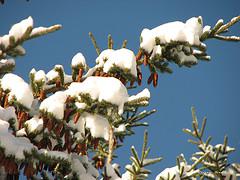
Image by clickclique via Flickr
This post is a guest post
Little ones love to play in the snow, but sometimes it’s not worth taking the time to bundle them up to play outdoors. The weather might be too cold, or perhaps the bundling process just takes too long. Why not bring the snow in? Filling a sensory table or shallow bucket with freshly fallen snow makes for a fantastic afternoon activity for children of all ages. No bundling necessary. Just pull out your sensory table or some shallow buckets, cover your workspace with towels, and get to work!
Snow Play for the Very Young
In addition to being a fun way to pass the time on a cold winter day, having a tray full of snow is a great sensory activity for even the youngest of kids. Indoor snow play is beneficial for kids as young as 2 years. These youngsters needed time to experience how snow feels on their skin, and how it reacted to various stimuli (ie poking it with a stick will leave a hole, and smashing it with their hands will pack it down).
It’s never too early to introduce scientific investigations with your tot. As the snow is melting, watch how it’s texture changes. Ask investigation questions such as “why does snow melt?” Take the time to introduce appropriate vocabulary words such as cold, icy, freezing, slushy, etc. Build on your youngster’s concept of snow by reading an age appropriate story.
Expanding Their Concept of Snow Through Creative Play
As your tot ages, it’s time to expand their concept of snow. They’ll leave the exploratory phase of snow play and enter the creative play stage. From their late 3′s through age 5 kids will enjoyed the fact that snow could be manipulated, as in cut with plastic knives into “cookies”, made into mountains for their cars to drive on etc. Consider filling their sensory buckets with items that would encourage them to mold the snow to fit their purposes.
Taking Creative Play to the Next Level.
As their creative play develops it’s a great idea to introduce new items that will add dimension to their play time. As preschoolers, my kids were particularly interested in sculpting snow into various shapes that they called “monsters”. Following their lead I would scour my cabinets for items that would enhance the project they were engaged in. Toothpicks and straws became arms, flat stones became eyeballs, etc. Every time you bring in a bucket of snow, introduce a new prop (such as buttons, plastic forks or paper cups) and challenge them to see how they can incorporate it into their play.
Scientific Investigations for Preschoolers
As you engage your youngster over a bucket of snow, don’t forget to engage their curiosity. Ask “what happens when…” questions, such as: “ What happens when you hold the snow in your hands too long?” or “What happens when we poke the snow with this?” another investigation prompt might be “which is better”. Questions might include “Which cuts through snow better? A butter knife or a pizza cutter…” or “Which makes better arms? A pipe cleaner or a toothpick…”
Get the Older Kids involved
Now that my children are 7 and 9 they don’t particularly need the exploratory or sensory aspect of coming into close contact with snow, but that doesn’t mean they don’t still love bringing buckets of snow indoors for an afternoon activity. Older children still love to create things with snow and found objects. Additionally, they generally like to use smaller toys that may better for indoor play. They love to create snowy scenes for their action figures to play in, drive their matchbox cars through the slush, and play “restaurant” with my cooking tools (ice cream scoops are particularly fun).
Using Snow for Scientific Investigations
Beyond the creative play, school aged kids are usually up for a scientific investigation that revolves around snow. With older children, you may be able to use scientific equipment as a springboard to your investigation. These bigger kids may be curious about weighing and measuring investigations. Suitable questions might include: “How long does it take for a snowball to melt entirely?” or “is snow heavier before you pack it down or after?”
Snow is a valuable resource for educators and parents alike. Besides the obvious benefits of it being free, and readily available in large quantities (for some of us) during the winter months the possibilities for its uses are only limited by one’s imagination. Whether you use snow for scientific investigations, sensory experiences, or imaginative play, its educational value for young children goes beyond measure.

